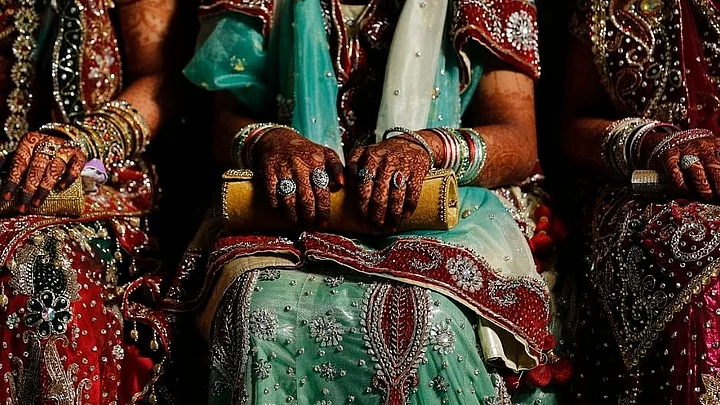(This was first published on 1 June. It has been republished from The Quint's archives to mark International Day for the Elimination of Violence Against Women on 25 November.)
The Supreme Court has recently passed a judgment explicating the law on dowry deaths in India. Section 304B of the Indian Penal Code, 1860 — the law in question — was introduced in 1986, specifically to tackle the growing menace of dowry deaths in India.
The SC, in its judgment, has lamented that dowry-related deaths continue unabated in present-day India.
Figures back this claim — according to the data provided by the National Crimes Record Bureau (NCRB), an average of 7352 cases were registered under section 304B, IPC nation-wide between 2016 and 2019.
Section 304B provides that when a woman dies due to burns or bodily injury or of unnatural circumstances, within seven years of her marriage and it is shown that soon before her death she was subjected to cruelty or harassment by her husband or his relatives in connection with any demand for dowry, such death shall be called ‘dowry death’.
The husband and his relative/s shall be presumed to have caused her death.
Reiteration of an Established Principle
The Bench has based its judgment on the premise that the phrase ‘soon before her death’ has proved to be contentious and aided acquittals. The SC chides trial courts for construing ‘soon before’ to mean ‘immediately before’ the death of the woman, an interpretation which is often difficult to prove for the prosecution.
The SC goes on to say that the term ‘soon before’ should be determined by establishing a ‘proximate and live link’ between the cruelty and the consequential death of the victim.
The SC has previously explored what constitutes ‘soon before’ as found in section 304B. In 2000, in the case of Kans Raj v. State of Punjab, (2000) 5 SCC 207, the Court observed that ‘soon before’ is a relative term, which should be considered under specific circumstances of each case.
A ‘proximate and live’ link between the effect of cruelty based on dowry demand, and the consequential death must be proved by the prosecution.
The demand of dowry, cruelty or harassment based upon such demand and the date of death should not be too remote in time which, under the circumstances, be treated as having become stale. A similar observation was made by the Court in Rajinder Singh v. State of Punjab, (2015) 6 SCC 477 in 2015.
Is ‘Soon Before’ Really the Problem?
These previous judgments made no attempt to explain how courts should arrive at ‘proximate and live link’ (an incident that is not immediately prior to the death of a woman, but not so remote that the cruelty itself has become stale), which rendered the observations rhetorical.
The recent SC judgment, similarly, does not lend itself to any clarity, and side steps the gravity and extent of the real problem.
According to data provided by the NCRB, more than 90 percent cases relating to dowry deaths are pending in trial courts across India. A considerable number of cases registered end in compromise between the accused and the family of the deceased, even though the law does not envisage any such compromise.
Within the minuscule proportion of cases that do get decided, the average conviction rate over the last five years has been a mere 36 percent.
Why Dowry-Related Harassment is Tough to Prove & the ‘Reluctance’ of Courts
The SC has assumed that cases end in acquittal owing to a flawed interpretation of the words ‘soon before’.
In reality though, the prosecution is largely unable to prove dowry harassment in the first place. Some of the reasons for this are obvious — aggrieved women, out of shame and fear of reprisal, do not share their plight with anybody, leaving no witnesses to vouch for said harassment.
Often, family members turn hostile and refuse to testify, thus collapsing the case of the prosecution. In cases where the prosecution is able to adduce evidence and witnesses, trial courts routinely reject the existence of any dowry-related harassment prior to a woman’s death. They reject the testimonies of the victims’ families, even dying declarations on inconsequential grounds and acquit on technicalities.
Largely, courts in India are reluctant to accept harassment of married women as harassment in relation to dowry.
If a woman is harassed after months, or years into her marriage, courts cite ‘passage of time’ to infer that the harassment does not constitute demand for dowry.
This, despite the law specifically providing that dowry demands can be made any time after the marriage.
When the main ingredient of the offence itself is not met, the question of interpretation of the term ‘soon before her death’ is redundant.
Why Onus Lies With Lower Judiciary
The Supreme Court is so removed from reality that it continues to make observations that have no bearing on the practices and workings of the police and lower courts.
Thousands of cruelty cases are compromised either by the police or the lower judiciary everyday. Women are encouraged to stay in abusive homes, leading to tragic consequences.
Trial courts are often biased against women and disregard the legislative intent of the provision they are enforcing.
A stand-alone order of the Supreme Court is likely to have no impact, unless the lower judiciary is sensitised to the plight of women, the legislative intent behind welfare legislations, and given a crash course in criminal procedure.
(Neha Singhal is a Senior Resident Fellow and leads work in the area of Criminal Justice. She was Deputy Director, Death Penalty Research Project at NLU, Delhi. She is a National Law School of India University (NLSIU) graduate, and holds a Masters in Criminal Justice from the University of Kent, Canterbury. This is an opinion piece, and the views expressed are the author’s own. The Quint neither endorses, nor is responsible for them.)
